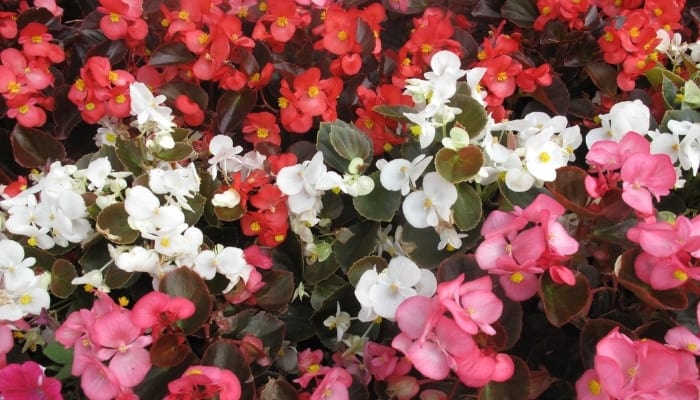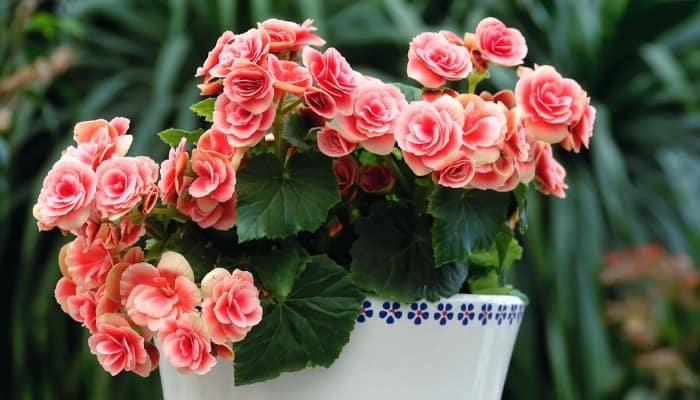Begonias make a great addition to any flower bed with their impressive size, beautiful hues, and extended blooming period.
Although they need more care and maintenance work than other hardy flowering plants in the garden, begonias are worth every ounce of work you put into them.
In theory, you can keep begonias blooming all season, but in reality, it’s not always that easy.
Between pests and diseases and the hot summer sun, these showy flowers are quite sensitive to any changes in the growing conditions around them.
Continue reading to find out how to keep begonias blooming all season with these 11 easy tips.
1. Select an Ideal Location
When it comes to making sure that your begonias will thrive in your flower bed, the first step is to make sure the plants have the right location in your garden.
Choose a spot that gets partial shade or dappled light. Direct exposure to full sunlight can stress out the plants and impact the blooms.
The ideal spot should be facing either the north or the east. That way the begonia will not have to struggle with the hot afternoon sun.
If you’re worried about direct sun exposure, plant the begonias in the partial shade of a tree that filters the light without cutting it off altogether.
2. Provide Nutrient-Rich Soil
To give your begonias a good start and ensure that they will bloom on time and in abundance, you should plant them in rich soil.
Before planting the begonias, test the soil and make sure it has all the basic nutrients. Even then, it doesn’t hurt to mix in organic fertilizers such as bone meal and homemade compost.
It also helps to till the soil before sowing the seeds or transplanting the seedlings. Turn the top 10 inches of the soil, mix in the organic compost, and let it rest under the sun for a week.
This oxygenates the soil and kills any pathogens to give the tuberous roots of the begonias the best chance to fatten up and develop fully.
3. Water Routinely
Regular watering is essential for the success of begonias and to ensure they keep blooming all season. As with fertilizing, you should water moderately but regularly.
How often you should water the begonias depends on the soil and how fast the moisture drains, but on average you should give them one inch of water per week. Factor any rainfall as part of that water quota.
To avoid overwatering, check the soil between irrigations. If the top inch of the soil is dry, then you can water it.
Irrigation is best done in the early morning to give the begonias time to absorb the moisture in the soil.
Keep in mind that begonias in containers need more frequent watering than those growing in flowerbeds.
4. Fertilize Regularly
Thanks to their large blooms, begonias need constant feeding both before and during the bloom season. However, you should be careful not to overfertilize the soil.
Both depleted soil and one with excessive nutrients will stress the plant and affect the flowers.
The general rule of thumb is to fertilize begonias lightly but steadily. Use fertilizers at half or quarter strength. A bloom booster fertilizer will encourage prolific flowers.
Begonias growing in the garden will need to be fertilized once every 3 weeks on average. If you’re growing them in containers, then apply the fertilizer once every 10 to 14 days.
Water immediately after each application to avoid root burn.
5. Maintain Correct Moisture Levels
One of the reasons you should not expose begonias to direct sunlight in the summer is that the moisture in the soil evaporates quickly.
While watering regularly is important for healthy begonias, it’s even more important to make sure the soil retains the moisture long enough for the roots to absorb it.
Mulching is often the ideal solution to soil that drains too quickly in the heat of the summer. The best mulch is shredded bark.
Use it lightly in a thin layer, and don’t let the mulch touch the stem of the begonias to avoid stem rot.

6. Provide Sufficient Lighting
Even though begonias are not big fans of direct sunlight in summer afternoons, that doesn’t mean that you should keep them in the shade.
Neither full sun nor full shade are recommended for begonias. Instead, you should provide partial shade or dappled light, such as the one filtered by the leaves and branches of a tree.
Begonias need about 6 hours of this filtered light during the bloom season.
Light deprivation will not only affect the size and colors of the blooms but also the number of blooms you get on each plant.
7. Avoid Hot Afternoon Sun
Exposure to the garish afternoon sun will stress the plant, cause the stems to wilt, and raise the temperature of the soil, which in turn leads to root damage.
A stressed begonia will go into a self-preservation mode. This means it will use the limited moisture and nutrients at its disposal to feed the roots and stems at the cost of the flowers.
If the begonias in the garden show signs of stress under the hot sun, consider installing a temporary shade to cut off the sunlight.
For begonias growing in containers and hanging baskets, move them away from the sun in the afternoon or, if indoors, draw a lace curtain across the window to filter out the light.
8. Be Sure Soil Drains Quickly
Another issue related to watering and begonias is root rot. The tuberous roots of the begonias don’t like to sit in wet or waterlogged soil.
They are susceptible to root rot in the presence of constant moisture in the soil. This is often a problem with clay soil that doesn’t drain quickly.
Check the texture of the soil before planting begonias. If the soil is heavy, amend it with coarse sand or perlite to improve drainage.
Loamy soil is the ideal soil to grow begonias. Sandy soil drains too fast for the begonia roots to benefit from the moisture.

9. Check Routinely for Pests and Diseases – Treat Promptly
Begonias attract many bugs and insects including slugs, snails, thrips, scales, mealy bugs, and spider mites.
They feed on the leaves and stems, which impacts the plant’s ability to develop robust foliage and flowers.
Check regularly for signs of pest infestations. Spray the pests with neem oil (I use this organic neem) or pesticides, and follow the instructions on the package.
As for diseases, begonias are prone to root and stem rot, Botrytis blight, powdery mildew, and Pythium root.
Some of these diseases are a result of pathogens that you can treat with the right fungicide. Root rot is caused by waterlogged soil, so you should allow the topsoil to dry between irrigations.
10. Repot When Necessary
Although most plants struggle when they get root bound, begonias thrive in small containers when their roots fill up the container.
However, after some point, there will be no more room in the container for the roots to grow. That can affect the amount of nutrients and moisture the plant gets, which in turn impacts the blooms.
There’s no clear-cut rule as to when you should repot begonias. It depends on the size of the pot and how fast the begonia is growing.
To check if your plant needs repotting, ease it out of the container and check the root ball.
If the roots are loose, put the begonia back in the pot, and let it grow until the roots come out of the drainage holes at the bottom.
11. Pinch Back Leggy Growth
If you feed the begonia with nitrogen-high fertilizers, it will develop robust foliage but fewer blooms. To encourage the plant to produce more buds, pinch back leggy growth.
This excessive growth often drains the plant’s resources. By cutting it back, the plant will focus on making more flowers instead.
Conclusion
Begonias are a delight to have in your garden thanks to their showy flowers. With the right care and ideal growing conditions, the plants can keep blooming all season.
Make sure to water begonias regularly, feed them lightly with mild fertilizers at a steady pace, and shield them from the hot afternoon sun. Then sit back and enjoy!

